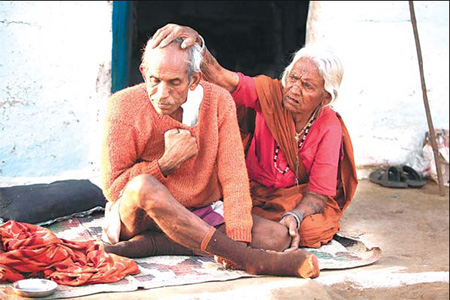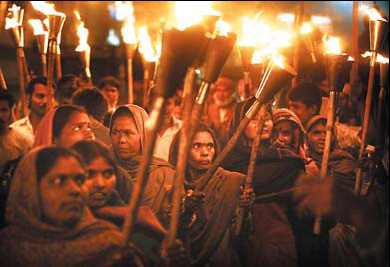Bhopal victims demand toxic cleanup
|
Eighty-year-old Rampyari Bai (right) and her sick son Bhawarlal, both affected by poison gas, sit in front of her home in a slum area near the Union Carbide Corp pesticide plant in Bhopal. |
|
Local activists attend a torch rally to mark the 25th anniversary of the Bhopal gas leak disaster. Reuters |
BHOPAL: Hundreds of people marched through Bhopal with torches before dawn yesterday to mark the 25th anniversary of the world's worst industrial disaster and demand the cleanup of toxic chemicals they say still contaminate the Indian city's soil and water.
Early on Dec 3, 1984, a pesticide plant run by Union Carbide spewed about 40 tons of deadly methyl isocyanate gas into the city's air, quickly killing about 4,000 people. The lingering effects of the poison raised the death toll to about 15,000 over the next few years, according to government estimates.
Local activists insist the real numbers are almost twice that, and say the company and government have failed to clean up toxic chemicals at the plant, which closed after the accident.
Once a shining symbol
It was seen as a symbol of the new emerging India - a factory that would not only generate thousands of jobs, but manufacture cheap pesticides for millions of farmers.
But it left a more potent legacy: the world's most deadly industrial disaster.
A quarter of a century on, the derelict factory stands abandoned, but behind its locked iron gates lies what environmentalists say is "a disaster within a disaster" - a highly polluted site which, according to a new study, is slowly poisoning the drinking water for thousands of Indians.
Bhopal has long cast a shadow over India and how it handles the challenges of a 1.1 billion, largely poor population, improve health and safety regulations, and a fast-growing economy.
"Our findings suggest that the entire site is highly contaminated," said Sunita Narain, director of the Delhi-based think-tank, the Center for Science and Environment (CSE), which in October tested the toxicity levels of ground water and soil samples.
"The factory site in Bhopal is leading to chronic toxicity, which is a continuous tiny exposure leading to poisoning of our bodies."
Protester march to plant
"Down with the government," and "Down with Union Carbide," the protesters chanted yesterday as they marched to the plant in Bhopal. "Punish the guilty and remove the toxic waste from the plant that still contaminates the soil and groundwater," said Rashid Bi, a victim who joined the march.
Union Carbide was bought by Dow Chemical Co. in 2001. Dow says the legal case was resolved in 1989 when Union Carbide settled with the Indian government for $470 million, and that all responsibility for the factory now rests with the government of the state of Madhya Pradesh, which now owns the site.
The government says at least 500,000 people were affected by the gas. Activists say thousands of children born to parents directly exposed to the gas or poisoned by contaminated water are suffering from brain damage, cleft lips, missing palates and twisted limbs. Skin, vision and breathing disorders also are common, they say.
"The enormity of that tragedy of neglect still gnaws at our collective conscience," Prime Minister Manmohan Singh said in a statement Wednesday.
"I reaffirm our government's commitment to resolving issues of safe drinking water, expeditious cleanup of the site, continuation of medical research, and any other outstanding issues," he said.
However, Babulal Gaur, the state minister for gas relief and rehabilitation, insists there is no current toxic contamination and dismisses assertions that the birth defects are related to the disaster. He says the diseases plaguing children are only a consequence of living in poor slums.
Union Carbide Corp., an American chemical company, said the accident was an act of sabotage by a disgruntled employee who was never identified, and not the result of lax safety standards or faulty plant design, as claimed by some activists.
Critics say the plant should not have used the gas, which is cheaper than less-hazardous alternatives, and should not have been located in a highly populated area.
AP-Reuters
(China Daily 12/04/2009 page12)
















